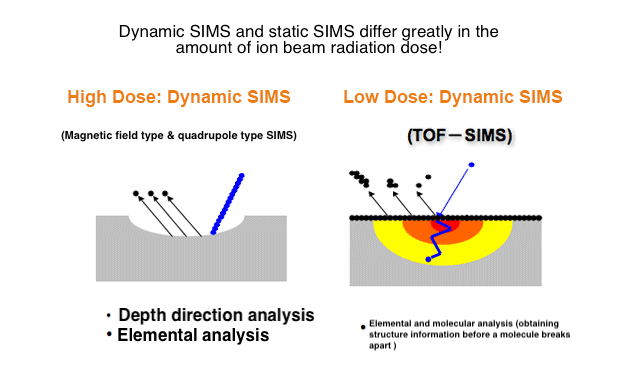What is the difference between SIMS and TOF-SIMS?
Home » What is the difference between SIMS and TOF-SIMS?
SIMS (Secondary Ion Mass Spectrometry) and TOF-SIMS (Time of Flight-SIMS) are the same in terms of mass analysis of secondary ions emitted by primary ion beam bombardment. They differ greatly in primary ion beam type, equipment, and information obtained. Therefore, it is a method with completely different uses as follows.
SIMS is a technique that can obtain the concentration distribution of impurities in the depth direction with high sensitivity by continuously bombarding a sample with a chemically active ion beam (cesium, oxygen). It is also called dynamic SIMS because the surface from which the secondary ions are emitted is “dynamic” in that it constantly recedes into the bulk of the material as the analysis proceeds. This technique is most often used to obtain dopant and impurity depth distributions. This is a quantitative analysis method indispensable for evaluating the impurity concentration in semiconductor materials.

On the other hand, TOF-SIMS is a technique that can detect elemental and molecular information existing on the outermost surface of a sample with a low primary ion beam dose (1×1012 atoms/cm2 or less). It is also called static SIMS because there is so little sputtering (<0.1% of a monolayer) during data acquisition that the surface is “static”. Virtually no sputtering takes place. The primary ion beam is a pulsed. The technique can be used to obtain molecular information on the outermost surface of the sample.
TOF-SIMS typically uses heavy ions (Bi, Au, Ga.) suitable for detection of molecular information on the surface, These species can be made easily into finely-focused ion beams which can be used to obtain high spatial-resolution ion images. This is an effective technique for identifying organic substances remaining on the surface. An auxiliary sputter source can also be mounted on the TOF-SIMS device so that secondary ions can be obtained from deeper into the material instead of being limited to just the sample surface. In that case, the detection sensitivity of elemental species is inferior to that of magnetic-sector SIMS or quadrupole SIMS instruments, but in-depth analysis is still possible.
Would you like to learn more about SIMS and TOF-SIMS?
Contact us today for your Dynamic SIMS and Static SIMS needs. Please complete the form below to have an EAG expert contact you.